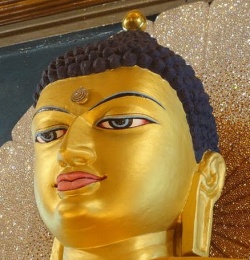Perennialist and Buddhist Views of Reality Part 2
I want to continue my last post and write now about the teachings on Emptiness in the Buddhist Mahayana and how they contrast with the metaphysics of the perennial philosophy.
The Buddha divided all truths into two kinds Conventional Truths and Ultimate Truths. All truths are one of these two kinds. There are different definitions of Conventional Truth depending upon which school of Buddhist tenets one holds. Likewise for Ultimate Truth. I shall speak here from what is considered the highest tenet system in the Mahayana the Prasangika Madhyamaka (or Middle Way).
In the Prasangika Madhyamaka Conventional Truth is just what the world says it is. In other words "the Tathagata (Buddha) does not argue with the world." He accepts whatever the world accepts as true in the ordinary world. So Conventional Truth is the truth as held by ordinary beings in the world. You might say it is the commonly accepted consensus about what is true.
Ultimate Truth is the Emptiness of all phenomena. Emptiness means a things own lack of any independent mode of existence. That is to say, no thing stands on its own from its own side or under its own power. It has no entity or essence that makes it what it is. It is also the case that no god makes things exist. There is no creator God upon whom all things depend in the Buddha teachings. So ultimately all phenomena are illusions. They do not exist the way they appear to sentient beings. Their mode of appearance and their mode of abiding are not the same for a sentient being
Emptiness and Conventional Truth are mutually dependent. It is not that Emptiness is superior and cancels out or makes Conventional Truth irrelevant. Ultimate Truth (Emptiness) and Conventional Truth are on the same level. They are mutually dependent according to the saying in the Heart Sutra - "Form is Emptiness; Emptiness is Form," - Form here standing for Coventional Truth and Emptiness for Ultimate Truth.
The Madhyamikas teach that Emptiness is Dependent Arising. This is so important to understand! There is no Emptiness without Form – without Conventional appearances. That is the radical insight of the Madhyamikas that brings heaven and earth together. This insight is not found in any other religion or philosophical system. The fact that conventional appearances are false – that the way they appear and the way they really abide is different is what reveals their Emptiness. If conventional appearances were true – if they existed the way they appear, then they would not be Empty – they would be truly existent. Make sure you understand this! A thing’s Emptiness is the fact that it does not truly exist as it appears to our senses. To the eyes, objects appear to stand out on their own without depending on anything else. But things do not abide that way. When we investigate them with reasoning, we cannot find any independent entity. So the fact that an object presents a false appearance not only covers or obscures the Ultimate Truth, it also at the same time and for the same reason reveals that Truth.
A thing that is non-Empty cannot be known. This is because a truly existent thing is an isolated thing. It does not depend on anything except itself. Therefore, it is an isolated monad. It cannot interact with anything else. It is only a thing’s Emptiness that relates it to other things and makes it capable of interaction. A non-Empty thing would be incapable of appearing to our minds and would therefore be completely unknowable. Such a thing is totally meaningless. If any such things exist, we can’t know about it.
Emptiness is a thing’s very own lack of any independent mode of existence. Emptiness, therefore makes the conventional truth possible. But notice, and this is the side that often gets short-shrift, the conventional world makes Emptiness possible. In western thought, we are used to a lack of symmetry between the Absolute and the World. The Absolute or God is in no way dependent on the phenomenal world. So we tend subconsciously to assume that the same sort of asymmetry applies as between Emptiness and the Conventional. But this asymmetry is not the case in the Buddhist Madhyamaka. Emptiness is always the Emptiness of some phenomena. There is no truly established Emptiness existing independent of phenomena like God exists independent of the world. This is the Emptiness of Emptiness. It is one of the sixteen Emptinesses taught by Chandrakirti in the Madhyamakavatara. An independently existing Emptiness would be a contradiction in terms. This teaching of the Emptiness of Emptiness cannot succumb to the charge of being pantheism because there is no kind of theism involved. We are in the realm of non-theism here.
Thus the Buddhist Madhyamaka does not entail a situation of better and worse with regard to Ultimate and Conventional Truth. It does not give rise to a denigration of conventional appearance or the World when understood correctly. Conventional appearance and Emptiness cannot really be separated as explained above. Emptiness is not higher or better than conventional truths or appearances. It is simply their true mode of existence.
So there is no way we can validly look on conventional appearances as lower, inferior, totally false in the Madhyamaka. We have to realize that unlike the situation in theism, where God or the Absolute is necessarily higher than and superior to appearances, in the Buddhist Madhyamaka, without appearances, there cannot be any Emptiness. That is, “Emptiness is also Form.” You just can’t separate the two in the Buddhist Madhyamaka.
So you see, the conclusion is that monotheism creates a hiatus between Reality (God) and the World because the Reality is somewhere else. Therefore theistic spirituality is always trying, in some sense to escape from the world through asceticism or through concentrating on a Reality outside the world. Whereas Buddhist Middle Way spirituality is all about being directly present right here and right now to whatever is manifesting without denigrating it or struggling against it.

